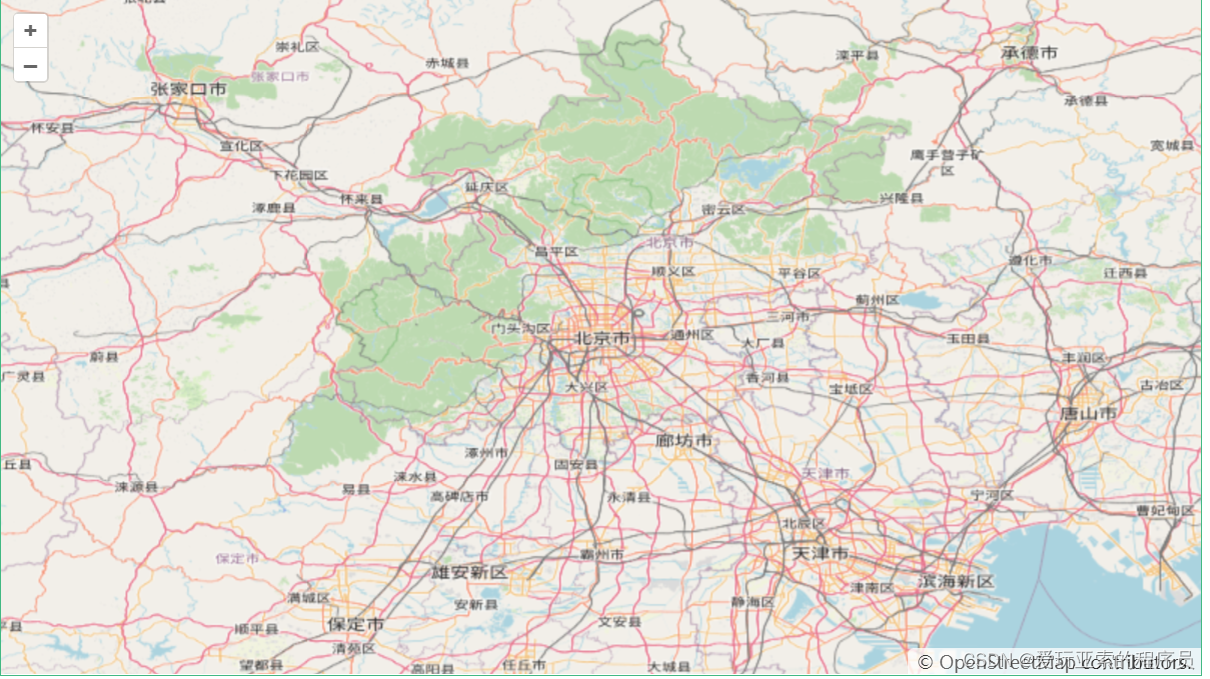openlayers [二] 初始化map 以及map的一些参数
发布时间:2024年01月17日
map 参数
controls 地图的控件
pixelRatio 设备上物理像素与设备无关像素(dip)之间的比率。
interactions 地图的互动
keyboardEventTarget 监听键盘事件的元素。这决定了KeyboardPan和 KeyboardZoom互动的触发时间。例如,如果将此选项设置为 document键盘,则交互将始终触发。如果未指定此选项,则库在其上侦听键盘事件的元素是地图目标(即用户为地图提供的div)。如果不是 document,则需要集中目标元素以发射关键事件,这要求目标元素具有tabindex属性。
layers 图层
maxTilesLoading 同时加载的最大瓦片数。
overlays 叠加层最初添加到地图中。默认情况下,不添加任何覆盖。
target 地图的容器
view 地图的视图
效果图

代码
<template>
<div class="container">
<h3>加载OpenStreetMap地图</h3>
<p>超爷openlayer</p>
<div id="vue-openlayers"></div>
<a href="https://xiehao.blog.csdn.net/article/details/105272407">
详情地址
</a>
</div>
</template>
<script setup>
import { ref, onMounted } from "vue";
import "ol/ol.css";
import { Map, View } from "ol";
import { Tile as TileLayer } from "ol/layer";
import { OSM } from "ol/source";
const map = ref(null);
const initMap = () => {
let osmLayer = new TileLayer({
source: new OSM(),
zIndex: 1,
});
map.value = new Map({
target: "vue-openlayers", //跟页面元素的 id 绑定来进行渲染
layers: [osmLayer],
view: new View({
//配置地图显示的options配置(坐标系,中心点,缩放级别等)
projection: "EPSG:4326",
center: [116.389, 39.903], //地图中心坐标
zoom: 8, //缩放级别
}),
});
};
onMounted(() => {
initMap();
});
</script>
<style scoped>
.container {
width: 840px;
height: 570px;
margin: 50px auto;
border: 1px solid #42b983;
}
#vue-openlayers {
width: 800px;
height: 450px;
margin: 0 auto;
border: 1px solid #42b983;
position: relative;
}
</style>
分析
1 首先页面需要先创建一个 div,用来绑定 map 地图上
<div id="vue-openlayers"></div>
2 下面是一个初始化地图的方法
const initMap = () => {
let osmLayer = new TileLayer({
source: new OSM(),
zIndex: 1,
});
map.value = new Map({
target: "vue-openlayers", //跟页面元素的 id 绑定来进行渲染
layers: [osmLayer],
view: new View({
//配置地图显示的options配置(坐标系,中心点,缩放级别等)
projection: "EPSG:4326",
center: [116.389, 39.903], //地图中心坐标
zoom: 8, //缩放级别
}),
});
};
前面的声明了三个变量分别是 容器(target),图层(layers),view(视图)。
通过实例化了一个OpenLayers的Map对象,于是就显示了地图!Map是什么
它是OpenLayers中最主要的对象!要初始化一幅地图,需要一个target,view,layers。
- target 主要是用来跟页面的元素进行绑定显示
- layers 我们看到,他其实是一个数组形式,那就说明它可以存在多个图层,这也是openlayers强大之处,非常实用。通过new Tile() 创建了一个图层,但是单单创建图层也是不行,图层里面必须要有数据,于是就有了 source: new OSM() 创建了一个OpenStreetMap提供的切片数据
- 同理,通过new View() 创建了一个视图对象
- center 设置默认地图中心点位置
- zoom 设置缩放等级
文章来源:https://blog.csdn.net/qq_45815947/article/details/135626968
本文来自互联网用户投稿,该文观点仅代表作者本人,不代表本站立场。本站仅提供信息存储空间服务,不拥有所有权,不承担相关法律责任。 如若内容造成侵权/违法违规/事实不符,请联系我的编程经验分享网邮箱:chenni525@qq.com进行投诉反馈,一经查实,立即删除!
本文来自互联网用户投稿,该文观点仅代表作者本人,不代表本站立场。本站仅提供信息存储空间服务,不拥有所有权,不承担相关法律责任。 如若内容造成侵权/违法违规/事实不符,请联系我的编程经验分享网邮箱:chenni525@qq.com进行投诉反馈,一经查实,立即删除!
最新文章
- Python教程
- 深入理解 MySQL 中的 HAVING 关键字和聚合函数
- Qt之QChar编码(1)
- MyBatis入门基础篇
- 用Python脚本实现FFmpeg批量转换
- GEE-R 中的 npphen 软件包简介(利用遥感时间序列重建地表物候和探测极端异常现象)
- 微店商品详情API(micro.item_get)的数据分析和挖掘
- Linux环境vscode clang-format格式化:vscode clang format command is not available
- C++力扣题目232--用栈实现队列
- 基于ssm的图书馆书库管理系统+vue论文
- 【QT】中英文切换
- 【Proteus仿真】【51单片机】电子称重秤
- 力扣labuladong——一刷day75
- Redis为什么那么快?
- python处理目录下文本文件去除空格和空行